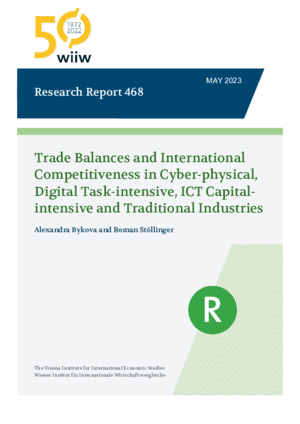Trade Balances and International Competitiveness in Cyber-physical, Digital Task-intensive, ICT Capital-intensive and Traditional Industries
Alexandra Bykova and Roman Stöllinger
wiiw Research Report No. 468, May 2023
38 pages including 6 Tables and 14 Figures
In this report, we analyse the international competitiveness of the EU in four industry groups over the period 1995-2018. The groups are delineated by specific factor intensities, where these intensities are assessed from digital tasks performed by labour services and ICT capital stocks. The EU’s positions relating to trade balances, revealed comparative advantages and unit value ratios are assessed relative to its main competitors, such as the US, China, Japan and South Korea. The trade specialisation patterns confirm EU advantages in traditional industries, which still represent the largest part of global trade, and in the group of digital task-intensive industries. In the cyber-physical group of industries, which are characterised by both high digital task and ICT capital intensities, the EU records a trade deficit, although this has been receding in recent years. Competitiveness indicators depict heterogeneity among EU countries. The loss of international competitiveness for some technology front-runners is a worrying sign. On the positive side, however, a reduction in trade deficits or an improvement in product quality and market shares is evident for certain EU countries, especially in the Central European region.
Keywords: international competitiveness, EU, EU-CEE, trade balances, revealed comparative advantages, unit value ratios, digital tasks, ICT capital, digitalisation
JEL classification: F14, L11, L60, O33
Countries covered: China, EU-CEE, European Union, Japan, South Korea, US
Research Areas: International Trade, Competitiveness and FDI
